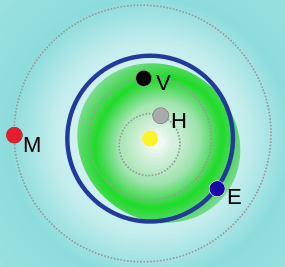1993 DA
| Discovery[1] | |
|---|---|
| Discovered by | Kitt Peak Spacewatch (Steward Observatory) |
| Discovery site | Kitt Peak southwest of Tucson, Arizona, USA |
| Discovery date | February 17, 1993 |
| Designations | |
| MPC designation | 1993 DA |
| MPO 164143 | |
Aten  NEO | |
| Orbital characteristics[2] | |
| Epoch 13 January 2016 (JD 2457400.5) | |
| Uncertainty parameter 6 | |
| Observation arc | 5 d |
| Aphelion | 1.0232 AU (153.07 Gm) |
| Perihelion | 0.84903 AU (127.013 Gm) |
| 0.93612 AU (140.042 Gm) | |
| Eccentricity | 0.093024 |
| 0.91 yr (330.8 d) | |
Average orbital speed | 30.718 km/s |
| 295.94° | |
| 1.0882°/day | |
| Inclination | 12.389° |
| 329.06093° | |
| 354.04° | |
| Earth MOID | 0.0341411 AU (5.10744 Gm) |
| Jupiter MOID | 4.09101 AU (612.006 Gm) |
| Physical characteristics | |
| Dimensions | 13–30 m[3] |
| 26.4[2] | |
|
| |
1993 DA is a small asteroid that is a Near-Earth object and an Aten asteroid.
Orbit
1993 DA was discovered February 17, 1993 by the Kitt Peak Spacewatch. From 1993 to 1998, 1993 DA was the asteroid with the lowest known aphelion at 1.023 AU, and was thus the closest thing to an Apohele asteroid known at the time.
When 1998 DK36 was discovered February 23, 1998, it was found to have an aphelion less than 1993 DA, and also less than the Earth's distance to the Sun (0.980 ± 0.05 AU), making it the first detected Apohele asteroid. However, 1998 DK36 was lost before the orbit could be confirmed, so 1993 DA retained the title of the asteroid with the lowest known aphelion. When (33342) 1998 WT24 was discovered November 25, 1998, it was found to have a slightly smaller aphelion (1.019 AU) than 1993 DA, so (33342) 1998 WT24 took the title. However, (33342) 1998 WT24 lost its smallest aphelion title almost immediately when (415713) 1998 XX2 (aphelion of 1.014 AU) was discovered only a few weeks later on December 8, 1998.
The orbit of 1993 DA brings it during the years 1900–2200 as close as 0.034 AU (5,100,000 km; 3,200,000 mi) of the Earth (on Feb 19, 1993) and as close as 0.13 AU (19,000,000 km; 12,000,000 mi) of Venus (on October 15, 1933, and Sept 30, 2077).[4] For comparison, the distance to the Moon is about 0.0026 AU (384,400 km).
Because the orbit was determined with only 5 days worth of observations, the orbit of 1993 DA has a uncertainty of 6 on a scale of 0 to 9, with 0 being the most certain, and 9 being the most uncertain. This uncertainty is common for small asteroids that are difficult to observe.
References
- ↑ "1993 DA". Minor Planet Center. 1993-02-22.
- 1 2 "JPL Small-Body Database Browser: (1993 DA)" (last observation: 1993-02-22; arc: 5 days). Jet Propulsion Laboratory. Retrieved 29 March 2016.
- ↑ "ABSOLUTE MAGNITUDE (H)". NASA.
- ↑ "JPL Small-Body Database Browser: (1993 DA) – Close-Approach Data". Jet Propulsion Laboratory. Retrieved 2015-06-05.
External links
- 1993 DA at the JPL Small-Body Database
